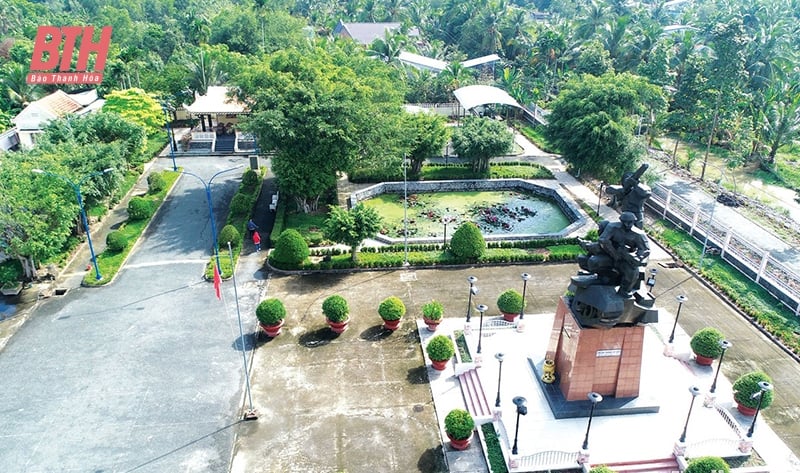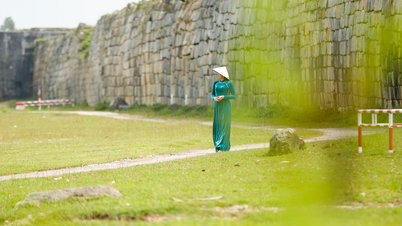The victory at Ap Bac signaled the failure of the "Special War" strategy(*)
The special national historical site of the Battle of Ấp Bắc is located in Tân Phú commune, Cai Lậy town, Tiền Giang province today. Photo: Ấp Bắc Newspaper
According to documents from the National Historical Museum, "the battle at Ap Bac on January 2, 1963, was the largest battle in South Vietnam since the Geneva Accords, signaling the collapse of the 'Special War' strategy that the US applied in its war of aggression against Vietnam." Since the 1960 Uprising, our policy was to proactively and gradually wage revolutionary war. However, the armed forces in South Vietnam, especially the main forces of Military Region 8, were small in number, lacked equipment, had not been trained to meet the demands of new combat, and were not prepared to counter modern war equipment and the enemy's "helicopter transport" and "armored vehicle transport" tactics.
Taking advantage of the flat terrain, the enemy forces applied and maximized the advantages of new war means and tactics, causing many difficulties and considerable losses for our armed forces in the South. Enemy aircraft created tension in the countryside, disrupting the lives and production of the people, and causing countless difficulties for the leaders of the revolutionary movement... It should be added that in the early 1960s, our assessment of the balance of forces was limited, and ideological work was not good, leading to fear of the enemy and overestimating them, especially fear of artillery, mechanized vehicles, and helicopters. This resulted in many of our officers and soldiers lacking determination and not actively resisting the enemy's offensives. Furthermore, from July to September 1962, in the My Tho province at that time, the enemy continuously used helicopters to attack deep into the liberated areas and revolutionary bases, causing significant damage and creating confusion and wavering morale among some cadres, soldiers, and the people. In response to this situation, the Military Region Party Committee and the Commander of Military Region 8 organized numerous conferences to analyze and assess the situation; and simultaneously devised countermeasures against the enemy's new sweeping tactics.
Faced with new demands, the army and people of South Vietnam demonstrated their determination to defeat the enemy's tactics using helicopters and armored vehicles. In Military Region 8, following the directives of the Regional Party Committee and the Military Region Command, agencies organized the dissemination and training of tactics to counter enemy sweeps, the arrangement of defensive positions, and techniques for shooting down aircraft and armored vehicles. On the night of December 31, 1962, Company 1, Battalion 261 (the main force of the Military Region) and Company 1, Battalion 514 of the local troops of My Tho province were stationed in Ap Bac and Tan Thoi to train in how to engage helicopters and armored vehicles; how to organize and deploy forces; how to build a system of fortifications and battle positions in villages and communes; and to coordinate with a platoon of engineers from My Tho province, a platoon of local troops from Chau Thanh district, and guerrillas from Tan Phu, Tan Hoi, and Diem Hy communes to prepare for the attack on the strategic hamlets of Giong Dua and Long Dinh.
Upon discovering our forces deployed at Ấp Bắc, the enemy rapidly mobilized troops and equipment, organizing the "Đức Thắng 1/13" operation to sweep through the area. The force consisted of 3 battalions of the 7th Infantry Division, 1 paratrooper battalion, 2 commando companies, 3 security companies, 3 militia companies, 13 M113 armored vehicles, 13 warships, 32 aircraft, and artillery positions of the 7th Division along Route 4, Long Định, and Phước Mỹ.
On the morning of January 2, 1963, from multiple directions—by land, water, and air—the enemy launched a sweep operation in Ap Bac. On land, they sent a security battalion along the Tan Hoi road, divided into two wings: one attacking Truong Ga Bridge, the other attacking Cau Sao Bridge. Both enemy wings were intercepted and lured into pre-prepared terrain by the guerrillas. Seizing the opportunity, the unit commanders ordered their troops to open fire to stop the advance, while simultaneously deploying mobile forces to attack the flanks of the enemy's assault formation. With courageous, daring, and resourceful fighting spirit, undeterred by the enemy's overwhelming power, the armed forces stationed there, along with the people of Ap Bac, resolutely held their ground and resisted the enemy's sweep. Caught by surprise, both land wings were quickly annihilated. Sharing the same fate as the two land-based offensives, the naval assault along the Nguyen Tan Thanh canal, consisting of 13 warships carrying enemy troops launching a flanking attack behind our defensive formation, was also fiercely repelled and suffered heavy losses.
Relying on the pre-prepared fortifications, trenches, and bunkers, and with all the weapons in their arsenal, the army and people of Ap Bac successively defeated all enemy attacks, eliminating 450 enemy soldiers, including 11 American advisors and technical personnel, shooting down 5 helicopters, damaging many others; destroying 3 M-113 armored vehicles, sinking 1 warship, and completely foiling the enemy's ambitious sweeping operation.
Experience has confirmed that the victory at Ap Bac was a masterful application of military art by the commander and the unit, which had been trained in a short period of time. The quality of the Southern armed forces had significantly improved, the efficiency of enemy destruction had increased, and the troops had gradually adapted to the terrain, determining appropriate fighting methods and forcing the enemy to fight according to our tactics. Although this was a counter-sweep battle, it was a battle with harmonious coordination between the three branches of the armed forces, between the forces directly confronting the sweep and the forces in the surrounding villages and hamlets; a seamless coordination between military and political struggle, engaging the enemy on the spot and engaging the enemy on a wider scale to stretch and disperse enemy forces, creating conditions for the fighting forces to achieve victory. This was also a victory of the combined strength of politics, military, and troop mobilization, creatively and skillfully combined, leaving many valuable lessons in theory and practice.
According to many historical documents, in the Battle of Ap Bac, our forces numbered only 350 men, while the enemy had 1,400 troops of all types with modern equipment and weapons. After the battle, our side suffered 18 killed and 39 wounded, while the enemy suffered 450 killed and wounded. The victory at Ap Bac encouraged the revolutionary struggle and opened up new possibilities for the revolution in the South to completely defeat the "Special War" strategy of the invading US imperialists; at the same time, it marked a new stage of development for the armed forces of the South.
Writing in the People's Army Newspaper at the end of 2024, Master Nguyen Ngoc Toan, from the Vietnam Military History Institute, reaffirmed: "The victory at Ap Bac marked the beginning of the defeat of the 'helicopter assault' and 'armored vehicle assault' tactics, considered 'new and effective,' signaling the failure of the 'Special War' strategy of the US and the puppet regime, strongly encouraging the army and people of the South to promote the 'Ap Bac Emulation Movement, killing the enemy and achieving merit.' From the Dong Khoi movement in 1960 to the Battle of Ap Bac in 1963, the revolutionary movement for national liberation spread throughout the South. These were the 'shots' that led to the Tet Offensive and Uprising of 1968, the major campaigns throughout the South afterwards, and then the historic Ho Chi Minh Campaign of 1975 to unify the country."
Linh Truong
(*) This article uses materials from the National Historical Museum, the People's Army Newspaper, the Ap Bac Newspaper, and many other historical sources.
Source: https://baothanhhoa.vn/chien-thang-ap-bac-bao-hieu-su-that-bai-cua-chien-luoc-chien-tranh-dac-biet-245906.htm







![[Photo] Prime Minister Pham Minh Chinh presides over a meeting on private sector economic development.](/_next/image?url=https%3A%2F%2Fvphoto.vietnam.vn%2Fthumb%2F1200x675%2Fvietnam%2Fresource%2FIMAGE%2F2025%2F12%2F20%2F1766237501876_thiet-ke-chua-co-ten-40-png.webp&w=3840&q=75)



























































































Comment (0)